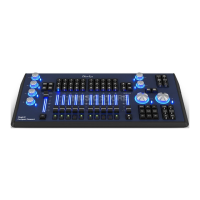
Do you have a question about the ChamSys MagicQ and is the answer not in the manual?
| Type | Lighting Control Console |
|---|---|
| Manufacturer | ChamSys |
| Software | MagicQ |
| Networking | Yes |
| MIDI Support | Yes |
| SMPTE Support | Yes |
| Cues | 5000 |
| Cue Stacks | 2000 |
| Encoders | Varies by model |
| Touchscreen | Yes |
| Universes | 64 |
| Number of fixtures | Unlimited (software dependent) |
| Network Ports | 4 |
| DMX Outputs | 4 |
| Inputs | MIDI, SMPTE |
| Compatibility | Windows, macOS, Linux (for software) |
| Features | Pixel Mapping |
| Faders | Varies by model (Mini Wing: 12, PC Wing: 10, MQ50: 12+12, MQ80: 10, MQ70: 10, MQ100 Pro: 10, MQ300 Pro: 15) |
Important safety precautions for operating the MagicQ console, including electrical safety.
Understanding how lighting states are stored as Cues and managed in Cue Stacks.
Explanation of the programmer's role in show data recording and live output control.
Steps to create a new show file, including programming mode selection.
How to configure and enable DMX outputs via direct ports or external interfaces.
Basic guide to patching heads and dimmers in the Patch Window.
Methods for selecting and controlling intelligent heads using groups and direct selection.
Steps for recording a look into a Cue on a playback.
How to play back recorded Cues and Cue Stacks using playbacks.
Detailed steps for patching fixtures and dimmers using the console.
Methods for selecting heads individually or using groups for control.
Adjusting head attributes like pan, tilt, colour, and gobo.
Steps to apply and modify effects using the FX engine.
Creating palette entries for attribute combinations.
Understanding what data is stored in the programmer and its priority.
Steps to record a look from the programmer into a Cue.
Configuring options for recording Cues, including masking and merge.
Loading Cue data back into the programmer for editing or reuse.
Modifying existing Cues by including and updating them.
Applying changes to multiple Cues simultaneously using merge or remove.
Configuring how faders activate, release, and control channels or FX.
Customizing the behaviour of playback buttons like Flash, Go, and Stop.
Steps to diagnose and resolve issues with no DMX output.
Troubleshooting steps when the console becomes unresponsive.